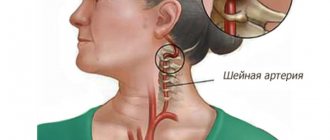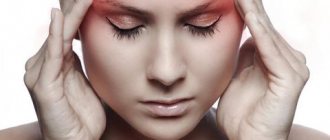Maltseva Marina Arnoldovna
Neurologist, specialist in the field of extrapyramidal pathologies, doctor of the highest category
Shabunina Ekaterina Mikhailovna
Neurologist, category 2
One of the common problems faced by modern people living in large cities and metropolises is throbbing pain in the temples. This symptom is an integral part and sign of many diseases and often turns out to be an alarming call to the presence of a serious pathology in the body of a person suffering from a headache.
Painful sensations arising in the temporal region are probably familiar to each of us; at least once in their life, every person has experienced a throbbing headache in the temples. Pain can occur on both sides or separately in the right or left temple. According to the sensation, the majority of the examined patients note that pain localized in the temporal areas and having a pulsating nature has a much greater intensity in comparison with diffuse or classic headaches.
Causes of throbbing pain in the temples
Throbbing pain in the temples can have many different causes, and therefore the approach to treatment will differ significantly. It is necessary to start with the fact that pain in the temples cannot be an independent disease and fighting only this symptom will be a pointless exercise. Throbbing pain in the temples can have a very diverse nature, but we can identify the main reasons for its formation and these include:
- Diseases of the cardiovascular system. The most common causes include atherosclerotic changes in the walls of blood vessels, which in turn lead to vascular disorders of an ischemic and metabolic nature in the nervous tissue of the brain.
- Infectious and inflammatory diseases of brain tissue. The most common infectious and inflammatory diseases of the central nervous system include: meningitis, encephalitis, ventriculitis and ependymatitis.
- Inflammatory diseases of the peripheral nervous system. In particular, neuritis of the facial or trigeminal nerve.
- Infectious and inflammatory diseases of the temporal arteries.
- Toxic damage to tissues of the central nervous system.
- Stressful situations and severe overexertion.
All of the above reasons may have a component in the clinical picture such as headache in the temporal region.
Local inflammatory diseases
Throbbing pain in the left or right temple can occur as a result of a unilateral inflammatory lesion, for example, with neuritis or arteritis. The inflammatory process leads to a reflex spasm of blood vessels in the area of the inflammatory process. which significantly impairs the trophism of surrounding tissues and causes ischemia. Ischemic damage leads to the formation of a pain syndrome localized in the area of damaged tissue, and inflammatory edema aggravates the situation. The cause of throbbing pain in the left temple is most often inflammation of the sensitive branches of the trigeminal nerve or inflammation of the facial nerve.
As for encephalitis and meningitis, these diseases lead to cerebral edema and a significant increase in intracranial pressure, which in turn forms a characteristic pain syndrome with localization of pain in the temporal regions.
Vegetovascular dystonia
The syndrome of vegetative-vascular dystonia, although not fully approved by many experts, still has a basis. Vegetovascular dystonia is a functional disorder. In which normal contraction of smooth muscle fibers cannot be carried out, a local increase in blood pressure may occur inside the vessels located in the brain tissue.
Pain in the temples of a vascular nature
In most cases, it is damage to the cerebral vessels that causes serious pain. Severe throbbing pain in the right temple may be associated with atherosclerotic lesions of the cerebral arteries belonging to the middle cerebral artery basin, less often the temporal artery itself. Since the brain has a complex nociceptive or pain system, when the baroreceptors located in the endothelium of the vessels are irritated, a severe pain syndrome is formed. Increased blood pressure in combination with atherosclerotic vascular lesions is the most common cause of throbbing pain in the temporal regions on both sides. Most patients note that when blood pressure rises, throbbing pain in the temples is often combined with pain in the back of the head. A one-sided headache with a predominant localization in any area of the head, in this case in the temporal region, is usually called migraine.
Osteochondrosis
One of the common causes of throbbing pain in the temples can be osteochondrosis of the cervical spine. Impaired mobility and configuration of the vertebrae leads to compression of the vertebral arteries and reduces blood flow through them. As a result of inadequate blood flow to parts of the brain, severe pain in the temples can occur. Almost always, such pain is accompanied by impaired coordination of movements and determination of the position of the body in space.
Oncological diseases
One of the symptoms of the development of malignant or benign neoplasms localized in the central nervous system may be the occurrence of pulsating or pounding headaches, especially when the tumor process is close to the cerebral arteries.
Tension headache
The most common type of cephalalgia, which is directly related to stretching and contraction of muscles and stress. The pain is dull and constant. Usually localized in the temples, forehead, neck or back of the head.
Treatment includes pain-relieving massage, hot showers, relaxation techniques, or any activity that may help relieve the attack. Over-the-counter analgesics often help. For very severe pain, stronger medications are recommended. These substances can cause slow reflexes and dizziness, so they should not be prescribed to people whose work requires increased attention. These medications should not be taken for more than a few days.
How is throbbing pain formed?
Pain in the temporal areas has a pulsating nature due to several reasons. The vascular component plays a major role in shaping the nature of pain. Ripple occurs as a result of:
- Rapid reflex angospasm. The narrowing of the diameter of the cerebral arteries, in particular the temporal one, leads to a sharp increase in vascular pressure.
- Atherosclerotic changes in blood vessels lead to thickening of their walls and a significant loss of elasticity, which leads to the formation of a more rigid pulse wave.
Environmental factors can lead to spasm of cerebral vessels. and internal factors of the body. Stressful situations often act as a provocateur, which lead to the release of biologically active substances into the blood - catecholamines, which have a spasmodic effect and sharply increase blood pressure. Also, throbbing pain can appear as a result of a sharp temperature change, for example, if you go out into the cold without a hat in winter, a spasm of the cerebral arteries occurs, which causes throbbing pain in the temples.
Rare causes
Sometimes, with more detailed laboratory and instrumental diagnostics, rare causes of pain and pulsation in the temporal region are discovered. Among them are the following:
- irritable bowel syndrome;
- Lyme disease;
- psychiatric diseases;
- heart defects;
- atrial fibrillation;
- respiratory failure;
- dental diseases;
- inflammation of the temporal artery, arteritis;
- aneurysm of the cerebral arteries;
- pathology of the temporomandibular joint, its dislocation, subluxation;
It's worth contacting a specialist
Let's not lie, of course it's worth it. A throbbing headache in the temples can be a transient symptom of a functional nature, for example with vascular dystonia, but much more often such pain is associated with serious diseases, the early diagnosis of which can significantly affect the treatment process and its results. So if you experience pain in your temples with a pulsating nature, you should not hesitate to seek advice from your doctor. Only timely diagnosis will help answer the question of what is the cause of such pain and how serious the pathology is.
If you notice one or more of the following symptoms in yourself or your loved ones, be sure to contact a specialist for qualified medical help.
- Painful sensations have a pronounced intensity;
- Pain in the temples does not go away for a long time, i.e. lasts more than 4-5 hours;
- The pulsation tends to increase and has a paroxysmal course;
- Throbbing pain is accompanied by severe nausea and vomiting without relief;
- The appearance of pain or its intensification during physical activity;
- Simultaneous increase in body temperature or local increase in temperature of the skin of the neck and face;
- Fixing consistently high blood pressure numbers - more than 140 and 90 mm. Hg Art.
Complications and prevention
If the pathological process is untimely or incorrectly treated, patients develop serious complications. Due to strong pulsation in the head, disorders appear that are of a mental nature. Patients complain of decreased quality of hearing and vision. A common complication of the pathology is stroke. Irrational therapy of the pathological condition leads to myocardial infarction. Patients' emotional state changes, which is accompanied by mood swings, apathy, and irritability.
To avoid the appearance of pulsation, it is recommended to carry out its prevention, which consists of following certain rules:
- It is recommended that a person get adequate sleep, the duration of which is 8 hours.
- It is recommended to give up bad habits - smoking and drinking alcohol.
- If a person leads a sedentary lifestyle, then he should regularly do eye and body exercises.
- To avoid the development of the disease, it is recommended to ensure moderate physical activity.
- A person should take a walk in the fresh air every day. The duration of the walks is at least 30 minutes.
- An excellent preventive measure is following a daily routine.
- The patient is advised to provide a healthy diet. He should eat vegetables, fruits and grains. It is strictly forbidden to eat fatty, fried, smoked and salty foods in large quantities.
Pulsation in the head area occurs when a person’s lifestyle is incorrect. It can be a symptom of severe and serious diseases. If throbbing pain occurs, the patient is advised to consult a doctor, who will prescribe effective treatment after diagnosis. Symptom therapy is aimed at relieving it and eliminating the causes of its occurrence.
Diagnostics
The cause of pain in the temples can be determined in different ways. The first thing a specialist begins with is interviewing the patient and clarifying the location of pain, because one-sided pain can already lead to the correct diagnostic path. Neurologists have noted that in almost 70% of cases, inflammation of the peripheral nerves innervating the temporal and facial zones is localized on the left side. Accordingly, a common cause of throbbing pain in the left temple is neuritis of the facial or trigeminal nerve.
In a diagnostic examination, in addition to collecting an anamnesis of the patient’s life and illness, instrumental examination methods are of great importance. So absolutely every patient with such a symptom as throbbing pain in the temples should be examined by a cardiologist, with electrocardiography and ultrasound examination of the heart. To confirm the vascular origin of pain in the temporal regions, duplex scanning of the carotid arteries and, if necessary, angiography of the vertebral, cerebral and carotid arteries are required to determine the degree of compensation of cerebral blood flow. Instrumental diagnostic studies also include: radiography of the cervical spine, magnetic resonance and computed tomography of the brain and neck. As well as other narrowly focused studies.
In addition to the cardiologist, the patient is examined by such specialists as:
- Neurologist and neurosurgeon;
- Psychiatrist;
- Therapist;
- Ophthalmologist;
- Cardiovascular surgeon.
Laboratory diagnostic methods are of great importance in the examination, because in most cases the cause of such pain is cardiovascular pathology. To confirm or exclude diseases of a vascular nature. As well as inflammatory studies, the following studies are carried out:
- Determination of lipid spectrum;
- Conducting general and biochemical blood tests;
- Determination of coagulogram;
- Lipid profile analysis;
Conducting a complete diagnostic study is necessary for the correct formation of treatment tactics, since only pathogenetic treatment with the elimination of the main source of pain in the temporal areas can be effective.
Treatment
Treatment of throbbing pain in the temples can be either conservative or surgical, although the second method is used much less frequently. Than to drug treatment.
Drug therapy may be effective for inflammatory diseases. Antibacterial therapy using broad-spectrum antibiotics helps to effectively fight severe infectious diseases of the brain; antibacterial therapy is also highly effective in combating local inflammation of the peripheral nerves, for example, with trigeminal or facial neuritis. In combination with antibacterial therapy for inflammatory diseases, anti-inflammatory drugs of both steroidal and non-steroidal nature are used, depending on the severity of the inflammatory process. It is important to note that the use of anti-inflammatory drugs with an analgesic component alone cannot eliminate the cause of the disease. Yes, the headache may go away, but it will definitely come back again, since its cause has not been eliminated.
Since vascular lesions and hypertension are common causes of pain, treatment of these diseases and compensation for hypertension lead to regression of symptoms such as pain in the temples. Properly formulated antihypertensive therapy can completely relieve the patient from headaches in the temporal regions that have a vascular origin, while the patient will save himself from unnecessary use of anti-inflammatory and analgesic drugs. Take good care of your body and be healthy!
Clinical Brain Institute Rating: 4/5 — 30 votes
Share article on social networks











